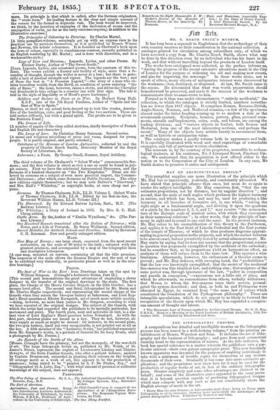HAT ON ARCHITEOTURAL DESIGN.*
This pamphlet supplies one more illustration of the principle which Mr. Hay has so ingeniously, zealously, and consistently advocated. We have stated that principle oftener than once, but must do so again to render the subject intelligible. Mr. Hay conceives, first, "that the eye estimates proportion; not by distance, but by angular direction " ; and second, that the scale of such angles which produces the highest harmony in nature, and which has been, and may be, used for producing a like harmony in all branches of formative art, is one which, "taking the right angle as a fundamental angle, and dividing it upon the quadrant of a circle by the numbers 2, 3, 5, and 7," may receive "the nomencla- ture of the diatonic scale of musical notes, with which they correspond in their numerical relations " ; in other words, that the principle of har- mony in sight and in sound is one and the same. In the present instance, Mr. Hay refers to his exemplification of this theory in the Parthenon, and applies it to the East front of Lincoln Cathedral and the East porde° of the temple of Theseus ; of which he thus produces diagrams approxi- mating in general proportion to the originals, and which the author believes to be almost exact, butnot yetstrictly tested by actual admeasurement. Mr. Hay starts by saying that he does not assume that the proportional science in question was prepensely exemplified by the architect of the cathedral ; but he considers that, as its proportions yield an harmonious effect, an analysis of them will reduce them to the same law. This appears a wise limitation. Afterwards, however, the enthusiasm of a theorist seems to prevail; and Mr. Hay deduces, with sweeping hand, the " probabilities " that the law was knowingly exemplified ; that the secret of the mediaeval free-masons was this identical law, and nothing else ; that sculpture of the same period was, through ignorance of the law, "paltry in composition and puerile in conception,"—expressions not a little out of place, and which he afterwards, on remonstrance from others, verbally withdraws; that Moses, to whom the free-masons trace their secrets, promul- gated the system described ; and that, as both he and Pythagoras were educated in Egypt, he reasoned from " the same law of nature which constituted the foundation of the Pythagorean philosophy." These are intangible speculations, which do not appear to us likely to forward the recognition of the theory upon which Mr. Hay has expended a conspicu- ous amount of thought and labour.
• The Harmonic Law of Nature applied to Architectural Design. By D. R. Hay, F.R.S.E. Read at a Meeting of the Royal Institute of British Architects, 13th No- vember 1854. Published by Blackwood and Sons.


































 Previous page
Previous page